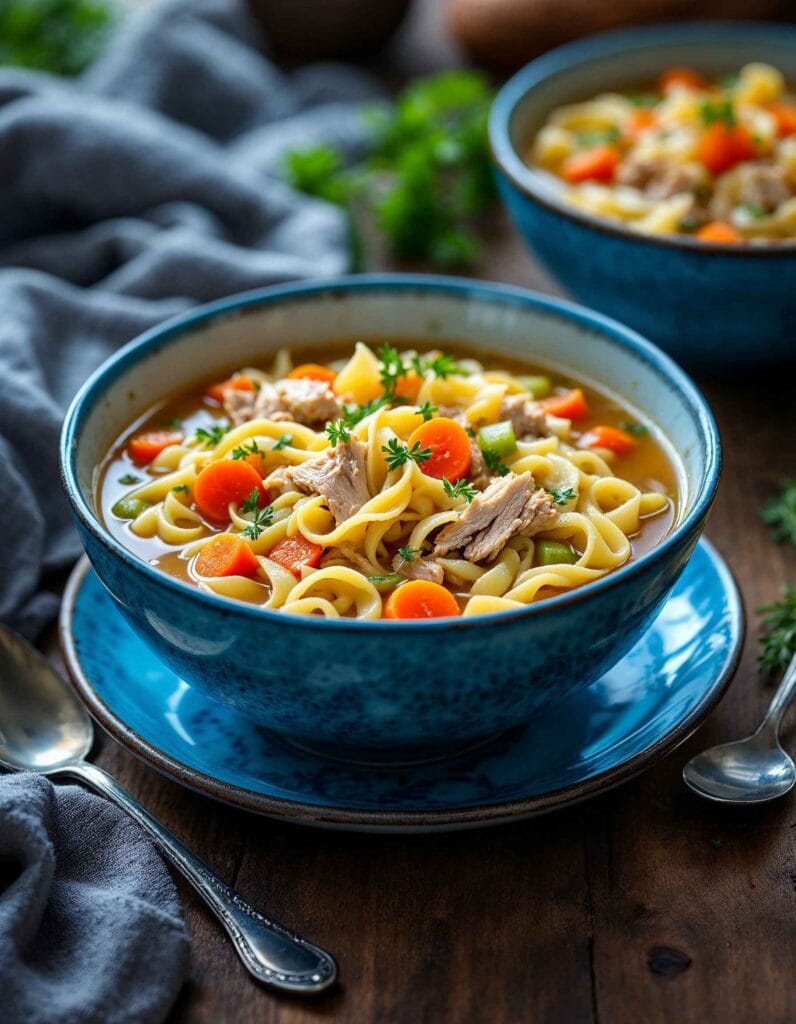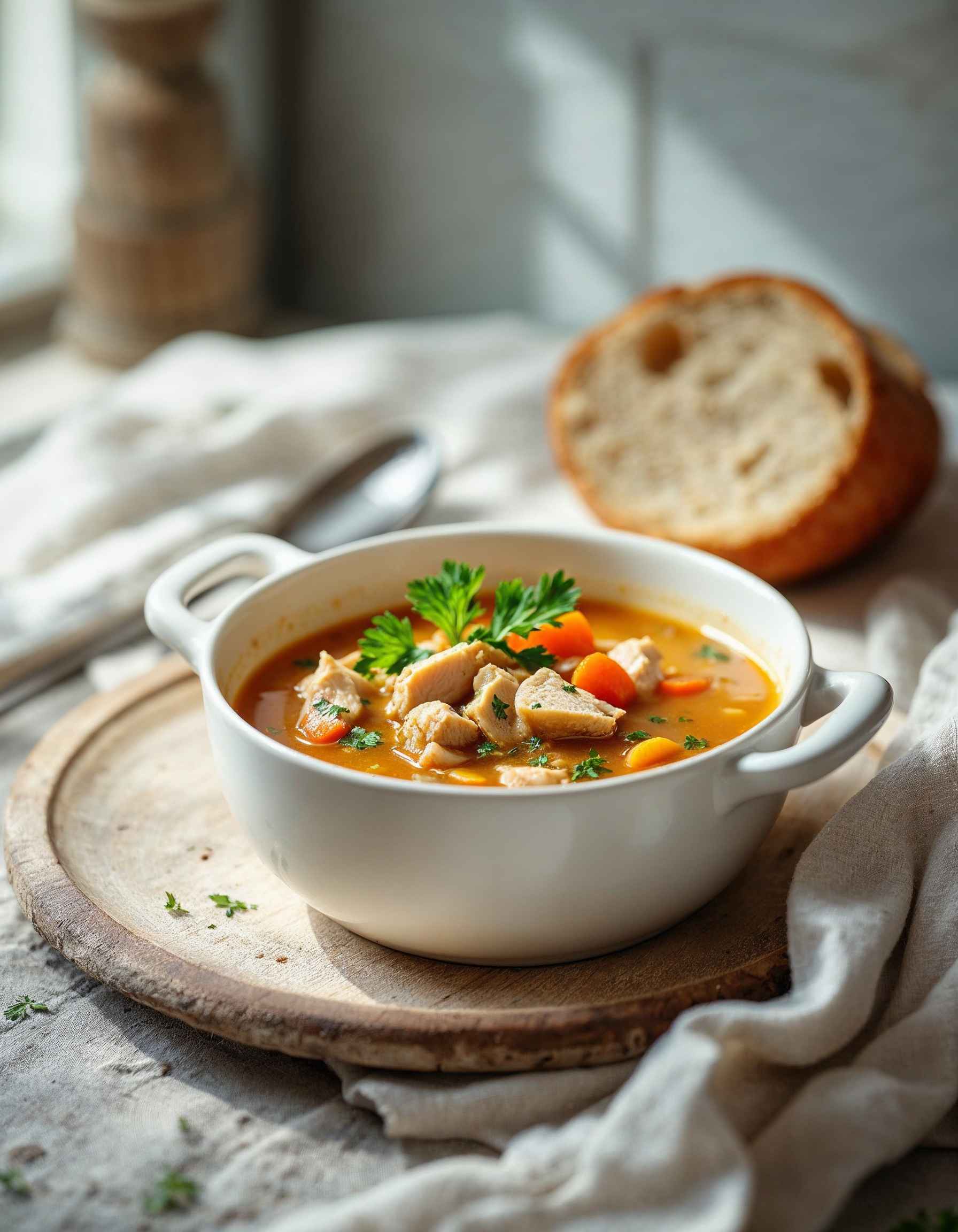How to Make the Perfect Turkey Soup Recipe: Easy, Delicious, and Comforting
Turkey Soup Recipe is a beloved dish, known for its ability to transform simple ingredients into a warm, nourishing meal. With its roots in traditional comfort food, turkey soup is more than just a way to use up leftovers—it’s a versatile recipe that can be customized to suit any palate. Whether you’re looking for a hearty winter meal or a light soup to pair with a sandwich, turkey soup offers endless possibilities.
One of the key appeals of turkey soup is its adaptability. You can use leftover turkey from holidays like Thanksgiving, incorporate seasonal vegetables, and even adjust the recipe to accommodate dietary preferences. It’s a meal that embodies the essence of homemade cooking: simple, satisfying, and deeply flavorful.
Learn how long soup stays safe to eat and explore tips for proper storage to avoid risks.
Benefits of Turkey Soup Recipe
Turkey soup isn’t just a delicious dish; it’s also packed with benefits that make it a household favorite.
Nutritional Value
Turkey soup is a nutrient-rich meal, offering protein, vitamins, and minerals in every bite. The turkey itself is a lean source of protein, essential for muscle repair and energy. When combined with vegetables like carrots, celery, and onions, the soup becomes a powerhouse of vitamins A and C, potassium, and fiber, promoting overall health and immunity.
Cost-Efficiency
Making turkey soup is an economical way to stretch your ingredients, especially after a holiday feast. By using leftover turkey and repurposing kitchen staples, you can create a filling meal without additional expenses. Homemade broth from the turkey carcass eliminates the need for store-bought options, reducing costs further while enhancing flavor.
Reducing Food Waste
One of the greatest advantages of turkey soup is its role in minimizing food waste. Instead of discarding leftover turkey bones, scraps, and vegetables, you can repurpose them into a delicious, hearty broth. This eco-friendly approach not only saves money but also ensures that no part of your meal goes to waste.
Turkey soup exemplifies the balance of nutrition, sustainability, and comfort that defines great cooking. It’s a dish that’s easy to love, whether you’re making it for yourself or sharing it with loved ones.
Essential Ingredients for Turkey Soup
Creating the perfect turkey soup begins with selecting the right ingredients. These components provide the foundation for a flavorful, wholesome dish. Whether you prefer a classic recipe or enjoy experimenting with add-ins, these essentials form the basis of any great turkey soup.
Selecting the Turkey
The turkey is the star of this dish, so choosing the right kind is crucial. Here are some options to consider:
- Leftover Turkey: Perfect for post-holiday cooking, leftover turkey adds a rich, roasted flavor to the soup. Both dark and white meat can be used, offering a balance of tenderness and taste.
- Fresh Turkey: If leftovers aren’t available, fresh turkey cuts like drumsticks, wings, or breast meat work wonderfully. They require a bit more cooking but yield tender results.
- Turkey Carcass: Don’t toss the turkey bones! They are essential for creating a rich, flavorful broth that forms the soup’s base.
Vegetables: The Heart of the Soup
Vegetables are the backbone of any soup, adding nutrients, texture, and flavor. For turkey soup, these are the must-haves:
- Carrots: Provide natural sweetness and vibrant color.
- Celery: Adds crunch and a fresh, aromatic quality.
- Onions: The foundation of flavor, giving depth and richness to the broth.
- Potatoes (Optional): For added heartiness, diced potatoes are a great addition.
You can also customize your vegetable mix with ingredients like zucchini, peas, or leafy greens like kale or spinach to suit your preferences.
Broth: The Soul of the Soup
The broth is where all the flavors come together, making it a critical component of turkey soup. Homemade broth, made by simmering turkey bones with aromatics, is ideal for a deep, robust flavor. However, store-bought broth or stock can be used as a convenient alternative.
Spices and Herbs: Enhancing the Flavor
The right combination of spices and herbs can elevate your turkey soup from ordinary to extraordinary. Here are some popular choices:
- Bay Leaves: Add a subtle, earthy flavor to the broth.
- Parsley: Fresh parsley brightens the soup and balances heavier flavors.
- Thyme and Rosemary: These herbs pair beautifully with turkey, enhancing its natural savoriness.
- Garlic: Crushed or minced garlic provides a warm, aromatic depth.
- Salt and Pepper: Essential for seasoning and bringing out the flavors of all ingredients.
Feel free to experiment with spices like paprika for smokiness or a dash of cayenne for heat.
Optional Add-Ins
For extra flavor and texture, consider incorporating optional add-ins:
- Noodles or Rice: Transform the soup into a heartier meal.
- Barley or Lentils: Great for adding fiber and a nutty taste.
- Cream or Milk: For a creamy variation, stir in a splash of cream or milk.
By thoughtfully selecting your ingredients, you can craft a turkey soup that’s as unique as it is delicious.
Step-by-Step Instructions for Turkey Soup
Making turkey soup is a straightforward process, but attention to detail ensures the best results. Follow this step-by-step guide to create a flavorful and hearty soup.
Step 1: Preparing the Broth
A rich, homemade broth is the foundation of a delicious turkey soup.
- Gather Ingredients: Use leftover turkey bones (carcass), onion quarters, celery stalks, carrot chunks, garlic cloves, and fresh herbs like parsley or thyme.
- Simmer the Broth: Place the turkey bones and aromatics in a large stockpot. Cover with water and add bay leaves, salt, and pepper.
- Cook: Bring to a boil, then reduce to a simmer. Allow the broth to cook for 2–3 hours, skimming off any foam or fat that rises to the surface.
- Strain: Once the broth is rich and golden, strain it through a fine-mesh sieve into another pot or bowl, discarding the solids.
Step 2: Sautéing Vegetables
Adding depth to the flavor begins with sautéing vegetables before adding them to the soup.
- Heat Oil or Butter: In a large pot, heat 2–3 tablespoons of olive oil or butter over medium heat.
- Add Aromatics: Sauté diced onions, garlic, and celery until they become soft and fragrant (about 5 minutes).
- Incorporate Carrots: Add chopped carrots and cook for an additional 3–4 minutes, stirring occasionally.
Step 3: Assembling the Soup
Now it’s time to bring everything together!
- Combine Broth and Vegetables: Pour the strained turkey broth into the pot with the sautéed vegetables.
- Add Turkey Meat: Shred or chop leftover turkey meat into bite-sized pieces and stir it into the soup.
- Season: Add bay leaves, thyme, rosemary, salt, and pepper to taste.
Step 4: Simmer and Adjust
Simmering allows the flavors to meld and deepen.
- Cook: Let the soup simmer over low heat for 20–30 minutes.
- Check the Flavor: Taste and adjust seasoning as needed, adding more salt, pepper, or herbs.
- Optional Add-Ins: If using noodles, rice, or other grains, cook them separately and stir them into the soup during the last 5–10 minutes of simmering to prevent overcooking.
Step 5: Serve and Enjoy
Finish your turkey soup with a few final touches:
- Garnish: Sprinkle fresh parsley or a squeeze of lemon juice over each bowl for brightness.
- Serve Hot: Pair the soup with crusty bread or a fresh salad for a complete meal.
This method ensures a turkey soup that’s both flavorful and satisfying, perfect for any occasion.
Variations of Turkey Soup
Turkey soup is a versatile dish that can be tailored to suit diverse tastes and dietary needs. Here are some creative variations to inspire your next pot of soup.
Classic Turkey Noodle Soup

This traditional version is a crowd-pleaser and ideal for chilly days.
- Key Ingredients:
- Egg noodles (or your favorite pasta)
- Classic turkey broth
- Vegetables like carrots, celery, and onions
- Preparation Tips:
- Cook the noodles separately to prevent them from absorbing too much broth.
- Add noodles to individual servings rather than the entire pot to maintain their texture.
Creamy Turkey Soup
For a rich and indulgent option, try a creamy variation of turkey soup.
- Key Ingredients:
- Heavy cream or whole milk
- A roux made with butter and flour for thickening
- Mushrooms or potatoes for added texture
- Preparation Tips:
- After simmering the broth and vegetables, stir in the roux and cream.
- Add a dash of nutmeg or white pepper for a subtle warmth.

Low-Carb Turkey Soup
A lighter option for those watching their carb intake.
- Key Ingredients:
- Zucchini noodles or cauliflower rice as substitutes for traditional carbs
- Leafy greens like spinach or kale
- Clear turkey broth seasoned with garlic and herbs
- Preparation Tips:
- Add greens toward the end of cooking to retain their vibrant color and nutrients.
- Enhance the flavor with a squeeze of lemon juice or a dash of turmeric.
These variations prove that turkey soup is far from boring. Each version offers a unique taste profile while maintaining the comforting essence of the original recipe.
Storing and Reheating Turkey Soup
One of the best things about turkey soup is its ability to taste even better the next day. Proper storage and reheating ensure that the flavors remain fresh and the soup stays safe to eat.

How to Store Turkey Soup
- Refrigeration:
- Allow the soup to cool to room temperature before storing.
- Transfer it to an airtight container to preserve flavor and prevent contamination.
- Store in the refrigerator for up to 3–4 days.
- Freezing:
- Turkey soup freezes exceptionally well, making it a great option for meal prep.
- Use freezer-safe containers or heavy-duty freezer bags. Leave about an inch of space at the top to account for expansion during freezing.
- Label the containers with the date for easy reference.
- Frozen turkey soup can be stored for up to 3 months without losing quality.
Reheating Turkey Soup
- On the Stovetop:
- Transfer the soup to a pot and reheat over medium heat.
- Stir occasionally to prevent sticking and ensure even heating.
- Add a splash of water or broth if the soup has thickened too much during storage.
- In the Microwave:
- Use a microwave-safe bowl and cover it loosely with a lid or microwave-safe wrap to prevent splattering.
- Heat on medium power in 1–2 minute intervals, stirring between each interval until the soup is hot.
- From Frozen:
- Thaw the soup overnight in the refrigerator for best results.
- If you’re in a hurry, place the frozen container in a bowl of warm water until it loosens.
- Reheat using either the stovetop or microwave method.
Tips for Maintaining Quality
- Separate Components: If your soup contains ingredients like noodles or rice, store them separately from the broth to prevent them from becoming overly soft or mushy.
- Avoid Repeated Reheating: Reheat only the portion you plan to eat to avoid altering the soup’s texture and flavor.
- Check for Freshness: If the soup develops an unusual odor, color, or texture, it’s best to discard it.
Proper storage and reheating ensure that your turkey soup remains just as delicious and nutritious as when it was first made, making it a convenient and versatile meal option.
FAQs
How to Store Homemade Turkey Soup?
Homemade turkey soup should be cooled to room temperature before storage. Place it in airtight containers and refrigerate for up to 3–4 days. For longer storage, freeze the soup in freezer-safe containers or bags for up to 3 months. Thaw overnight in the fridge before reheating.
Turkey Soup Recipe Using Leftovers
Leftovers are perfect for making turkey soup. Use the turkey carcass to create a rich broth, then shred the leftover meat and add it along with vegetables, spices, and grains like rice or barley. This method minimizes food waste while creating a hearty, flavorful dish.
What Is a Good Side Dish for Soup?
Soup pairs well with crusty bread, garlic bread, or a fresh green salad. For a heartier option, consider a grilled cheese sandwich or biscuits. These sides complement the soup’s flavors while adding variety to your meal.
Can I Eat Soup After 7 Days?
It’s not recommended to eat soup that has been refrigerated for more than 3–4 days due to the risk of bacterial growth. If you plan to keep soup longer, freeze it immediately after cooling to preserve its freshness and safety.
Conclusion
Turkey soup recipe is a timeless recipe that combines comfort, flavor, and practicality. With its ability to transform simple ingredients into a wholesome meal, it’s perfect for any occasion, from family dinners to quick lunches. Whether you stick to a classic recipe or explore creative variations, turkey soup is a dish that everyone can enjoy.
Now that you know how to make and customize this versatile soup, it’s time to gather your ingredients and start cooking. Your perfect bowl of turkey soup awaits!







